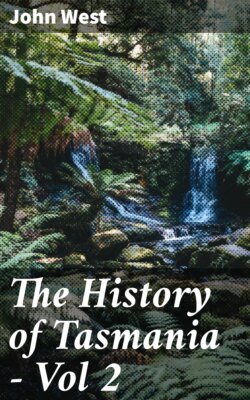The History of Tasmania - Vol 2

Реклама. ООО «ЛитРес», ИНН: 7719571260.
Оглавление
John West. The History of Tasmania - Vol 2
The History of Tasmania - Vol 2
Table of Contents
THE ABORIGINES
SECTION I
Footnote
SECTION II
Footnote
SECTION III
Footnote
SECTION IV
Footnote
SECTION V
Footnote
SECTION VI
Footnote
SECTION VII
Footnote
SECTION VIII
Footnote
SECTION IX
Footnote
SECTION X
Footnote
HISTORY OF TASMANIA. TRANSPORTATION
TRANSPORTATION
SECTION I
Footnote
SECTION II
Footnote
SECTION III
Footnote
SECTION IV
Footnote
SECTION V
Footnote
SECTION VI
Footnote
SECTION VII
Footnote
SECTION VIII
Footnote
SECTION IX
Footnote
SECTION X
Footnote
SECTION XI
Footnote
SECTION XII
Footnote
SECTION XIII
Footnote
SECTION XIV
Footnote
SECTION XV
Footnote
SECTION XVI
Footnote
SECTION XVII
Footnote
SECTION XVIII
Footnote
SECTION XIX
Footnote
SECTION XX
Footnote
SECTION XXI
Footnote
SECTION XXII
Footnote
SECTION XXIII
Footnote
SECTION XXIV
Footnote
SECTION XXV
Footnote
SECTION XXVI
Footnote
SECTION XXVII
Footnote
HISTORY OF TASMANIA. CONCLUSION
CONCLUSION
Footnote
HISTORY OF TASMANIA. ALPHABETICAL ACCOUNT OF CHIEF PLACES
LIST OF CHIEF PLACES
NOTES AND ERRATA
THE END
Отрывок из книги
John West
Published by Good Press, 2021
.....
Thus the food, on which the people depended for subsistence, was diminished, and the temptation to rob the settlers was regularly augmented at every return. Sir George Arthur, in his letter to the Secretary of State in 1828, notices this topic as a complaint of the natives against the intrusion of the whites, and seems to admit its truth; but three years after, he affirms that game was still abundant in the districts appointed for the tribes. It is, however, to be observed, that he wrote when the blacks, as a people, were dead; and when the high value of labor had withdrawn many from the chase; and that he implies a local, rather than a pervading abundance. As the natives passed through the settled districts to the sea shore, if numerous, their requirements would be great; but, by scattering themselves abroad, to obtain a sufficiency, their dangers would increase, and every evening they would muster fewer than in the morning.[11]
Among the causes of enmity, referred to by writers of every period, the abduction of the women by sealers and others, is noticed the earliest, and continued to the last. The sealers were, chiefly, either convicts whose sentences had expired, or such as contrived to escape. In the islands of the Straits, they indulged the boundless license of their passions, blending the professions of the petty pirate and the fisherman. A chain of rocks enabled them to rove to a considerable distance, picking up the refuse of the sea, and feeding on the aquatic birds which frequented the islets in great abundance. Many, however, perished, with the frail boats to which they committed their lives. Their first stage was known as "Clarke's Island;" from thence they made "Preservation Island:" a succession of rocks formed land marks in their course to New Holland, from which many found their way to Kangaroo Island, the Ultima Thule of their geography. In these places, they engaged in sealing; the produce of which they sold to the small craft trading among them, for guns, spirits, and tobacco. When the season was over, they [Pg 23]retired to the interior, and passed their days in alternate slumber and intoxication.
.....